Bird Dog Exercise: Know the Details!
This may be one of the most common exercises in the rehabilitation and fitness world. I love it, but it can go very wrong, really quick.
Why is it called bird dog?
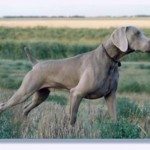 Have you ever watched a bird dog on point? When they find a bird (or a rabbit in my dog’s case), they instantly stabilize their body and stand still. From that stabilization and active stillness, they slowly move their legs forward, one at a time (It can take 10 minutes for them to move 1 foot!). At one point in that forward progression, their front leg and opposite back leg are suspended in space.
Have you ever watched a bird dog on point? When they find a bird (or a rabbit in my dog’s case), they instantly stabilize their body and stand still. From that stabilization and active stillness, they slowly move their legs forward, one at a time (It can take 10 minutes for them to move 1 foot!). At one point in that forward progression, their front leg and opposite back leg are suspended in space.
What it should look like
What it should NOT look like (and I see this all the time!)
Muscular Benefits:
- Transverse abdominus and internal oblique: stabilize neutral pelvis
- Lumbar Multifidus: control spinal rotation
- Gluteus maximus: acts as an extender of the hip on the leg side
- Gluteus medius: acts as a stabilizer on the knee side
- Scapular stabilizers: the hand on the floor
- Scapular muscle strength: the arm reaching out
I mentioned a new muscle in this post: lumbar multifidus. This muscle group is so complex and interesting, it deserves a post all its own. For now, here is a very brief explanation of its role during the bird dog exercise.
The lumbar multifidi (plural for multifidus) are segmental stabilizers of the spine. The attachments and insertions criss-cross multiple levels, giving it a very unique look and function. In bird dog, it helps control rotation of the spine to help maintain neutral pelvis. It is a highly important muscle, but often not trained appropriately. We know from research that these little guys like to go to sleep with chronic low back pain. The good news? They can be trained to wake right back up!
Blog Activity
I have to start by saying I tried to make a video of the elephant walk. But, because the movement is so finite, it was difficult to see unless my gluteus was directly in your view. I wasn’t willing to go there yet for the purpose of education.
ELEPHANT WALK (lumbar multifidus training)
On your hands and knees, place your hands under your shoulders and knees under your hips. You should be in neutral spine. Engage your core by pulling your belly button away from the floor. Keeping your right foot relaxed on the floor, barely lift your right knee off the floor without shifting your body to the left. Place the right knee down and repeat on the other side. This is a very small movement and termed the elephant walk by a patient of mine years ago. Once you master it, there is a resemblance to the large mammal. This walk is THE KEY to initiate bird dog correctly.
BIRD DOG
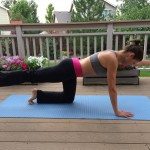 Initiate the elephant walk with the right leg. Slide the right leg behind you and lift it off the floor, but ONLY TO HIP HEIGHT. Raising it higher than the hip will cause lumbar compression, an unhealthy position for the spine. The leg should shoot straight out from the hip. The glutes, core and multifidi are now engaged together to stabilize the trunk. Extend your opposite arm out and reach your fingers away from your toes. This creates increased stabilization to the trunk. You should feel your entire body engaged in the exercise.
Initiate the elephant walk with the right leg. Slide the right leg behind you and lift it off the floor, but ONLY TO HIP HEIGHT. Raising it higher than the hip will cause lumbar compression, an unhealthy position for the spine. The leg should shoot straight out from the hip. The glutes, core and multifidi are now engaged together to stabilize the trunk. Extend your opposite arm out and reach your fingers away from your toes. This creates increased stabilization to the trunk. You should feel your entire body engaged in the exercise.
© 2014 and Beyond. ALL BLOG CONTENT at duncansportspt.com by Lori Duncan PT
ABOUT THE AUTHOR
 Lori Duncan, DPT, MTC, CPT is a respected Physical Therapist, Manual Therapist and Pilates instructor in Lafayette, CO. Lori is passionate about preventive physical therapy and education and is a nationally recognized presenter. She can be reached at [email protected]. You can also follow Duncan Sports Therapy + Wellness on Facebook & Instagram for more free tips and information.
Lori Duncan, DPT, MTC, CPT is a respected Physical Therapist, Manual Therapist and Pilates instructor in Lafayette, CO. Lori is passionate about preventive physical therapy and education and is a nationally recognized presenter. She can be reached at [email protected]. You can also follow Duncan Sports Therapy + Wellness on Facebook & Instagram for more free tips and information.


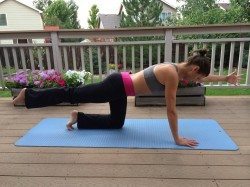
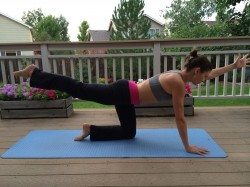
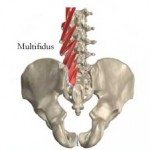
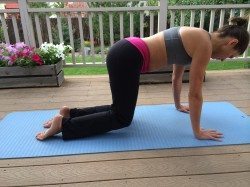
I have most of my back fused and a rod in my spine. Will these exercises hurt my back or disturb the rod. I am 6 months out from surgery.
Hi Jan,
Are you fused into your lumbar spine or just thoracic? The level of fusion would make a difference.
I get pain behind the knees ra specially if I try to bring it close to the tummy and then bag to straight position
Hi Shun,
That usually happens when you’re trying to use your hamstring too much to bring the knee in, instead of the deep abdominals. Think about your leg anchored in your core for the final knee bend. Hope that helps!
I’m having the same issue as shun, the back of my knee experience pain when I try to move my legs up. I just want to verify whether its from tight hamstrings are because i’m using my hamstrings too much
Hi Marc,
You are likely using your HS too much. That position is not really stretching the hamstring. My advice would be to slide your leg back (before even lifting) and reach the other arm out. Then, barely lift that lift that leg off the ground and see if you feel the glute.
Thanks
Lori, thanks so much for all this info. I’ve been slowly going through your site and have found it informative. I have a herniated disc at L4/5 (confirmed by MRI) with slight nerve root compression. So for me, would lumbar extension not be a good approach (a la the classic MacKenzie exercise)? Thus, could I benefit from modifying your bird dog by raising the leg higher (even though you advise not to do this) to achieve lumbar compression and coax my disc back in under the vertebrae? Again, thanks for your help with these posts and videos, it’s much appreciated.
Hi Sean,
McKenzie is a very specific thought theory and they believe that extension is “putting the disc back in place.” Although I don’t believe in that (no research to support), I do believe that some spines prefer extension over flexion and vice versa. In general, when trying to stabilize the spine and get the core to truly activate, neutral spine is the best place to start. If you would like to add the prone press-up (on stomach, pushing body up into extension and only if extension relieves your symptoms) I would do that as a separate exercise. I would still recommend bird dog in neutral spine for pure core activation.
Lori, thanks for your reply. For me, the Mackenzie extension has been a life saver and has pulled me back from the brink of another bad episode on multiple occasions. I do not know if it is physically coaxing the disc back in but it certainly is the best exercise I’ve found to relive symptoms and prevent another episode. I’m absolutely certain that I would have put my back out multiple other times without it. The only problem is that it stresses my hamstrings so I also need to address that. I’ll keep the birddog level as you advise but continue with the extensions and glute exercises + hip mobility stuff that you recommend. Thanks again, Sean.
Great “how to” and “how not to”. I wouldn’t say the back extension is an “ouch”, but it’s not the purpose of the exercise. Loved the addition of the real life bird dog in the explanation as a dog lover myself!